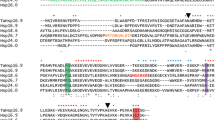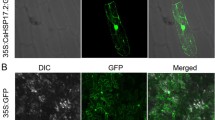Abstract
The gene encoding the small heat shock protein (sHSP), LeHSP21.5, has been previously cloned from tomato (GenBank accession no. AB026983). The deduced amino acid sequence of this tomato sHSP was most similar to that of other endoplasmic reticulum (ER)-localized sHSPs (ER-sHSP) and can be predicted to target the ER. We examined whether the gene product of LeHSP21.5 (probable ER-sHSP) can act as molecular chaperone. For functional analysis, LeHSP21.5 protein was expressed in Escherichia coli as His6-tagged protein in the C-terminal and purified. We confirmed that ER-sHSP could provide thermal protection of soluble proteins in vitro. We compared the thermal stability of E. coli strain BL21 (DE3) transformed with pET-ER-sHSP with the control E. coli strain BL21(DE3) transformed with only the pET vector under heat shock and IPTG-induced conditions. Most of the protein extracts from E. coli cells expressing ER-sHSP were protected from heat-induced denaturation, whereas extracts from cells not expressing ER-sHSP were very heat-sensitive under these conditions. A similar protective effect was observed when purified ER-sHSP was added to an E. coli cell extract. ER-sHSP prevented the thermal aggregation and inactivation of citrate synthase. These collective findings indicate that ER-sHSP can function as a molecular chaperone in vitro.




Similar content being viewed by others
Abbreviations
- CS:
-
citrate synthase
- ER-sHSP:
-
endoplasmic reticulum-located small heat shock protein
- HEPES:
-
4-(2-hydroxyethyl)-1-piperazineethanesulfonic acid
- IPTG:
-
isopropyl-1-thio-β-d-galacto-pyranoside
- LDH:
-
lactate dehydrogenase
- ME:
-
mercaptoethanol
- PVPP:
-
Polyvinylpolypyrrolidone
- sHSP(s):
-
small heat shock protein(s)
References
Arranco R, Almoguera C, Jordano J (1997) A plant small heat shock protein gene expressed during zygotic embryogenesis but non-inducible by heat stress. J Biol Chem 272:27470–27475
Arrigo AP, Landry J (1994) Expression and function of the low-molecular-weight heat shock proteins. In: Morimoto R, Tissieres A, Georgopoulus C (eds) The biology of heat shock proteins and molecular chaperones. Cold Spring Harbor Laboratory Press, New York, pp 335–373
Atkinson BC, Raizada M, Bouchard RA, Frappier JRH, Walden DB (1993) The independent stage-specific expression of the 18-kDa heat shock protein genes during microsporogenesis in Zea Mays L. Dev Genet 14:15–26
Boston RS, Viitanen PV, Vierling E (1996) Molecular chaperones and protein folding in plants. Plant Mol Biol 32:191–222
Collada C, Gomez R, Casado R, Aragoncillo C (1997) Purification and in vitro chaperone activity of a class I small heat-shock protein abundant in recalcitrant chestnut seeds. Plant Physiol 115:71–77
Cooper P, Ho THD (1987) Intracellular localization of heat shock proteins in maize. Plant Physiol 84:1197–1203
Ehrnsperger M, Graber S, Gaestel M, Buchner J (1997) Binding of non-native protein to Hsp25 during heat shock creates a reservoir of folding intermediates for reactivation. EMBO J 16:221–229
Forreiter C, Kirschner M, Nover L (1997) Stable transformation of an Arabidopsis cell suspension culture with firefly luciferase providing a cellular system for analysis of chaperone activity in vivo. Plant Cell 9:2171–2181
Fujikawa S, Ukaji N, Yamane K, Nagao M, Takezawa D, Arakawa K (2006) Functional role of winter-accumulating proteins from mulberry tree in adaptation to winter-induced stresses. In: Chen T, Uemura M, Fujikawa S (eds) Cold hardiness in plants. Molecular genetics, cell biology and physiology. CABI Press, UK, pp 181–202
Giese KC, Vierling E (2002) Changes in oligomerization are essential for the chaperone activity of a small heat shock protein in vivo and in vitro. J Biol Chem 277:46310–46318
Helm KW, LaFayette PR, Nabao RT, Key JL, Vierling E (1993) Localization of small heat shock proteins to higher plant endomembrane system. Mol Cell Biol 13:238–247
Helm KW, Schmeits J, Vierling E (1995) An enomembrane-locatlized small heat-shock protein from Arabidopsis thaliana. Plant Physiol 107:287–288
Joe MK, Park SM, Lee YS, Hwang DS, Hong CB (2000) High temperature stress resistance of Escherichia coli induced by a tobacco class I low molecular weight heat-shock protein. Mol Cells 10:519–524
Kim KP, Joe MK, Hong CB (2004) Tobacco small heat-shock protein, NtHSP18.2, has a broad substrate range as a molecular chaperone. Plant Sci 167:1017–1025
Kim R, Kim KK, Yokota H, Kim SH (1998) Small heat shock protein of Methanococcus jannaschii, a hyperthermophile. Proc Natl Acad Sci USA 95:9129–9133
Kobayashi Y, Kobayashi E, Sato S, Hotta Y, Miyajima M (1994) Characterization of cDNAs induced in meiotic prophase in lily microsporocytes. DNA Res 1:15–26
Laemmli UK (1970) Cleavage of structural proteins during the assembly of the head of bacteriophage T4. Nature 227:680–685
LaFayette PR, Nagao RT, O’Grady K, Vierling E, Key JL (1996) Molecular characterization of cDNAs encoding low-molecular-weight heat shock proteins of soybean. Plant Mol Biol 30:159–169
Lee GJ, Pokala N, Vierling E (1995) Structure and in vitro molecular chaperone activity of cytosolic small heat shock proteins from pea. J Biol Chem 270:10432–10438
Lee GJ, Roseman AM, Saibul HR, Vierling E (1997) A small heat shock proteins stable binds heat-denatured model substrates and can maintain a substrate in a folding-competent state. EMBO J 16:659–671
Leroux MR, Melki R, Gordon B, Batelier G, Candido EPM (1997) Structure-function studies on small heat shock protein oligomeric assembly and interaction with unfolded polypeptides. J Biol Chem 272:24646–24656
Liu J, Shono M (1999) Characterization of mitochondria-located small heat shock protein in tomato (Lycopersicon esculentum). Plant Cell Physiol 40:1297–1304
Lopez-Matas M, Nuñez P, Soto A, Allona I, Casado R, Collada C, Guevara M-A, Aragoncillo G, Gomez L (2004) Protein cryoprotective activity of a cytosolic small heat shock protein that accumulates constitutively in chestnut stems and is up-regulated by low and high temperatures. Plant Physiol 134:1708–1717
Magnard JL, Vergne P, Dunas D (1996) Complexity and genetic variability heat-shock protein expression in isolated maize microspores. Plant Physiol 111:1085–1096
Merck KB, Groenen PJTA, Voorter CEM, de Haard-Hoekman WA, Horwitz J, Boemendal H, de Jong WW (1993) Structural and functional similarities of bovine alpha-crystallin and mouse small heat-shock protein, a family of chaperones. J Biol Chem 268:1046–1052
Morrow G, Inaguma Y, Kato K, Tanguay RM (2000) The small heat shock protein Hsp22 of Drosophila melanogaster is a mitochondrial protein displaying oligomeric organization. J Biol Chem 275:31204–31210
Sabehat A, Weiss D, Lurie S (1996) The correlation between heat-shock protein accumulation and persistence and chilling tolerance in tomato fruit. Plant Physiol 110:531–537
Sanmiya K, Suzuki K, Egawa Y, Shono M (2004) Mitochondrial small heat-shock protein enhances thermotolerance in tobacco plants. FEBS Lett 557:265–268
Sanmiya K, Suzuki K, Tagri A, Egawa Y, Shono M (2005) Ovule-spesific expression of the genes for mitochondrial and endoplasmic reticulum localized small heat-shock proteins in tomato flower. Plant Cell Tissue Organ Cult 83:245–250
Scharf D, Siddique M, Vierling E (2001) The expanding family of Arabidopsis thaliana small heat stress proteins and a new family of proteins containing α-crystallin domains (Acd proteins). Cell Stress Chaperones 6:225–237
Smýkal P, Mašin J, Krdý I, Konopásek I, Zárský V (2000) Chaperone activity of tobacco HSP18, a small heat-shock protein, is inhibited by ATP. Plant J 23:703–713
Sticher L, Biswas AK, Bush DS, Jones RL (1990) Heat shock inhibits α-amylase synthesis in barley aleurone without inhibiting the activity of endoplasmic reticulum marker enzymes. Plant Physiol 92:506–513
Sun W, Bernard C, van de Cotte B, Montagu MV, Verbruggen N (2001) At-HSP17.6A, encoding a small heat-shock protein in Arabidopsis, can enhance osmotolerance upon overexpression. Plant J 27:407–415
Sun W, Van Montagu M, Verbruggen N (2002) Small heat shock proteins and stress tolerance in plants. Biochim Biophys Acta 1577:1–9
Ukaji N, Kuwabara C, Takezawa D, Arakawa K, Yoshida S, Fujikawa S (1999) Accumulation of small heat-shock protein homologs in the edoplasmic reticulum of cortical parenchyma cells in mulberry in association with seasonal cold acclimation. Plant Physiol 120:481–489
van Berkel J, Salamini F, Gebhardt C (1994) Transcripts accumulating during cold storage of potato (Solanum tuberosum L.) tubers are sequence related to stress-responsive genes. Plant Physiol 104:445–452
Vierling E (1991) The role of heat shock-proteins in plant. Annu Rev Plant Physiol Plant Mol Biol 42:579–620
Vierling E, Nagao RT, DeRocher AE, Harris LM (1988) A heat shock protein localized to chloroplasts is a member of a eukaryotic superfamily of heat shock proteins. EMBO J 7:575–581
Waters ER, Lee GJ, Vierling E (1996) Evolution, structure and function of small heat shock proteins in plant. J Exp Bot 47:325–338
Wehmeyer N, Hernandez LD, Finkelstein RR, Vierling E (1996) Synthesis of small heat-shock protein is part of developmental program of late seed maturation. Plant Physiol 112:747–757
Yeh CH, Chang PFL, Yeh KW, Lin WC, Chen YM, Lin CY (1997) Expression of a gene encoding a 16.9-kDa heat-shock protein, Oshsp16.9, in Escherichia coli enhances thermotolerance. Proc Natl Acad Sci USA 94:10967–10972
Zarsky V, Garrido D, Eller N, Tupy J, Vicente O, Schoffl F, Heberle-Bors E (1995) The expression of small heat shock gene is activated during induction of tobacco pollen embryo genesis by starvation. Plant Cell Environ 18:139–147
Zhao C, Shono M, Sun A, Yi S, Li M, Liu J (2007) Constitutive expression of an endoplasmic reticulum small heat shock protein alleviates endoplasmic reticulum stress in transgenic tomato. J Plant Physiol 164:835–841
Acknowledgments
This work was supported in part by funds from the Bio-oriented Technology Research Advancement Institution. We thank Jennifer Calcaterra and Drs. Kempton Horken and Hasanova Gulnara at the University of Nebraska-Lincoln (USA) for a critical reading of the manuscript.
Author information
Authors and Affiliations
Corresponding author
Electronic supplementary material
Below is the link to the electronic supplementary material.
10265_2008_148_MOESM1_ESM.doc
Supplementary Fig. 1. Immunoblot analysis of tomato plant expressing LeHSP21.5 protein. Tomato plant growing and subcellular fractionation was performed as described in Materials and Methods. Ten microliters of total proteins from each fraction were run on 12% SDS-PAGE and transferred to PVDF membrane. Immunoblotting was performed using anti-LeHSP21.5 polyclonal antibody. 1: 25°C, 10,000x g supernatant; 2: 25°C, 200,000× g pellet; 3: 25°C, 200,000× g supernatant; 4: 40°C, 10,000× g supernatant; 5: 40°C, 200,000× g pellet; 6: 40°C, 200,000× g supernatant. (DOC 378 kb)
Rights and permissions
About this article
Cite this article
Mamedov, T.G., Shono, M. Molecular chaperone activity of tomato (Lycopersicon esculentum) endoplasmic reticulum-located small heat shock protein. J Plant Res 121, 235–243 (2008). https://doi.org/10.1007/s10265-008-0148-x
Received:
Accepted:
Published:
Issue Date:
DOI: https://doi.org/10.1007/s10265-008-0148-x




